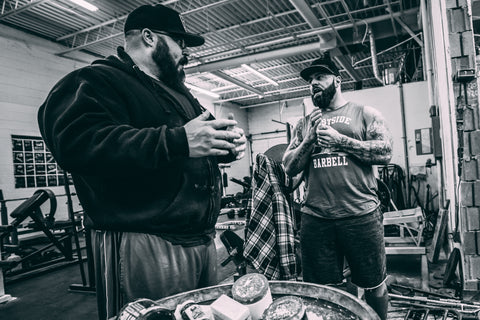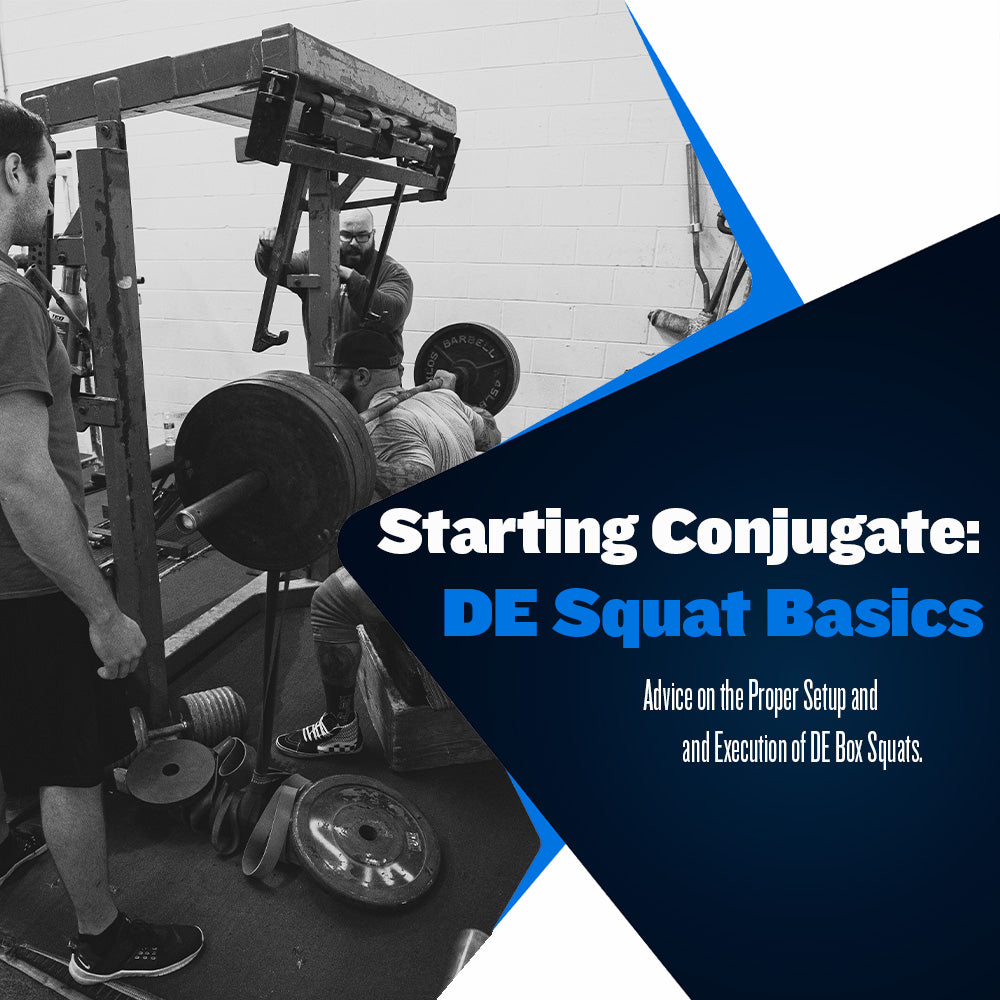Starting Conjugate: Dynamic Effort Squat Basics

In strength sports, it is easy to get caught up in the idea that to get stronger, all you need to do is lift heavy to develop absolute strength and hammer volume work to increase muscle mass. While developing tremendous amounts of absolute strength and muscle mass will certainly get you stronger, a big piece of the equation is still missing.
Dynamic effort training, or "DE" training, is used to increase the rate of force development and accumulate additional volume in sport-relative multi-joint movements. At Westside, we use the dynamic effort method to improve our RFD for the squat, bench, and deadlift.
When you first begin a Conjugate Method training program, the dynamic effort method is probably the method you will struggle with the most in terms of proper setup and execution. When training the max or repetition effort method, execution is straightforward; load up some weight and lift it for a max set of 1-3 reps or multiple sets and reps focusing on hypertrophy.
This is not to say that execution does not matter on those training days; it certainly does. We always want to perform exercises with the strictest form we can manage. However, what makes dynamic effort difficult for the beginner is the number of things you have to get right for the training to be maximally effective.
During a dynamic effort lower training day, you must have your box height set at the right height, your bar weight correct, your bands appropriately anchored, and execute each rep with the proper intent for every set.
Here are a few tips to make sure you are starting on the right path:
Box Height
The box squat provides multiple benefits. When a box squat is performed correctly, we gain a static-overcome-by-dynamic training effect and a relaxed-overcome-by-dynamic training effect. Introducing these training effects ultimately leads to an increased rate of force development and a stronger and more explosive athlete.
However, for these gains to correctly translate to sport, the box height must be set so that joint angles are relevant to competition depth. Failure to do so will leave you weak where it matters most - out of the hole. A proper box height will have you generating tremendous amounts of power when transitioning from eccentric stretch to concentric contraction.
It's simple; all you need to do is set your box at a height that places you at competition-legal depth. If performing your DE squats to a competition-legal box height forces you to use weights lighter than what your percentages work out to, so be it. It is more important to execute your reps with the proper bar speed at the appropriate depth than it is to lift the exact weights the percentages say you should.
Bar Weight
Our typical DE lower squat wave is performed at 75% the first week, 80% the second week, and 85% the third week. If we were to train using a 5 x 5 rep scheme, each of these percentages should be reduced by 5%. Accommodating resistance will always remain fixed and makeup 25% of the total weekly weight.
Figuring out proper bar weight and accommodating resistance tension is the most common place individuals make mistakes when setting up their DE lower training. Here is an example that should help to simplify the process:
Set and Rep Scheme: Week 1 - 12 x 2 @75% / Week 2 - 10 x 2 @80% / Week 3 - 8 x 2 @85%
Lifter’s Max Squat = 1000lbs
75% = 750 (50% bar weight, 25% band weight)
80% = 800 (55% bar weight, 25% band weight)
85% = 850 (60% bar weight, 25% band weight)
Now, we break these weights down to ensure the proper bar weight and accommodating resistance tension is loaded.
Week 1 = 500 bar weight + 250 band weight
Week 2 = 550 bar weight + 250 band weight
Week 3 = 600 bar weight + 250 band weight
Anchoring Bands
To get your band tensions correct, you must anchor your bands properly. There are many ways to accomplish this, as long as the band remains engaged throughout the entire ROM and the top weight tension is correct. To measure this, we typically use a fishing or luggage scale.
We need to have the bands at proper tension throughout the entire ROM to ensure that athletes can benefit from the overspeed eccentric effect the bands have on the barbell. Faster eccentric means faster concentric; this is where we want to be.
So, the way you go about anchoring your bands does not matter as long as they are anchored in a way that ensures the bands remain engaged throughout the lift and apply the correct weight at lockout.
Execution and Intent
Once you have your setup right, it is time to get your mind right. Dynamic effort training depends heavily on the athlete's ability to execute each rep with the proper intent. Our dynamic effort days are often referred to as "speed days"; without explosive execution, you limit your ability to improve rate of force development and ultimately turn speed day into another volume day.
Does this mean you should abandon form and move as fast as you recklessly can? Of course not. What we want are controlled reps performed as explosively as possible. Adherence to form during dynamic effort training days is as important as on max effort days. Not only does this allow us to protect ourselves from injury, but it also ensures the proper muscle groups are engaged and benefit maximally.
Now, you may run into a situation where the percentage dictates you use a bar weight that you cannot make ideal speed with. The solution here is simple: reduce the weight by 10-15lbs so you can move with the right amount of bar speed. Going forward, the solution is just as simple. Each week you will reduce the working bar weight by 10-15lbs.
You will continue to do this until you can complete a three-week wave using the correct bar weights dictated by the percentages. If you have to make this adjustment, ensure you are honest with yourself. Are you slow because the bar weight is too heavy, or are you being lazy? Do you still need to work at lower bar weights, or are you capable of performing the correct bar weights but avoiding the work?
As with any method, the effectiveness of the dynamic effort method will depend heavily on the lifter's intent and execution. A lazy mindset with lackadaisical execution will lead you nowhere, while an aggressive attitude with razor-sharp execution will rapidly improve your competition lifts. It's on you as the lifter to ensure you get these things right.
Check out the rest of the Starting Conjugate series to learn more about how to properly set up your Conjugate Method training.
Sources:
Simmons, L. (2007). Westside Barbell Book of Methods. Westside Barbell.
Verkhoshansky, Y., & Siff, M. C. (2009). Supertraining. Verkhoshansky.





